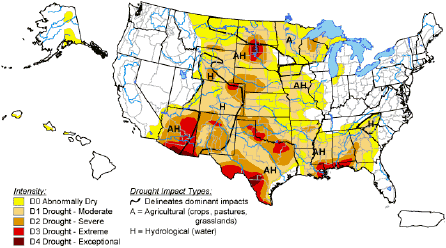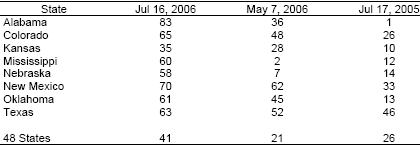



Impact of Drought on Stocker Cattle Management and Marketing
By John D. Anderson, MSU Extension Livestock Economist - Stocker grazing represents an important part of the overall beef supply chain. Grazing operations add value both to standing forages as well as to light weight stocker calves. Stocker grazing operations encompass a fairly wide variety of production systems.In the Southeast, including Mississippi, stocker grazing is generally associated with winter grazing on annual ryegrass. Further north in the region, into Tennessee and Kentucky, calves are sometimes grazed on stockpiled fescue or other cool-season grass. The most intensive stocker grazing operations are probably those in the Southern Plains, where calves are turned out on wheat pasture.
Demand for grazing calves is an important component, at certain times of the year the most important component, of demand for calves from the Southeastern region. Therefore, anything that impacts the viability of stocker grazing operations is likely to have an effect on calf prices. This year, persistent – and spreading – drought conditions could very well influence stocker grazing decisions as we move toward the end of the summer season. It is worth taking a quick look at what conditions around the country are looking like right now.
Currently, drought conditions are becoming widespread across many parts of the country that are very influential in the cattle market. The map in Figure 1 shows the weekly drought monitor produced by USDA for mid-July. This map shows abnormally dry to extreme drought conditions covering most of the country’s midsection, including the Southern Plains and most of the Southeast.
The impact of this dry weather on current grazing conditions has been, in many states, quite dramatic. Table 1 summarizes pasture and range conditions as reported by USDA for a number of key states and for the entire nation. This table reports the percentage of pasture and rangeland acres rated as being in Very Poor or Poor Condition. Ratings for mid-July of this year are compared to ratings for the first week of May (the first week of the year for which pasture and range conditions are reported) as well as to ratings for mid-July last year.
The data in Table 1 indicate that pasture and range conditions have deteriorated significantly throughout the year. In Mississippi, which began the year in pretty good shape, the decline in pasture conditions has been very dramatic. Many other states (for example, Texas and Oklahoma) were already dry at the beginning of the year and have only gotten worse. Overall, a large number of states are experiencing considerably worse pasture and range conditions than last year at this time. This is evidenced not only by the individual state data presented in Table 1 but also by the average pasture and range condition score for all of the lower 48 states.
Figure 1. U.S. Drought Monitor

Table 1. Percent of Pasture and Range Acreage Rated Poor or Very Poor for Selected States and U.S.

This year’s widespread drought has a number of implications for the cattle market. First of all, the intensity of the drought in major cattle producing states like Texas and Oklahoma will make it difficult to continue the expansion of the beef herd. Many producers will find it difficult to maintain the herd they have, much less continue increasing numbers. The drought may not halt herd expansion all together, but it will, at the very least, slow the pace of expansion, thus affecting the level of beef production further down the road. Longer term, a reduction in beef production will be supportive of cattle prices. In the short run, of course, the forced sales of increasing numbers of cattle will not be good for prices, certainly not at the local market level.
Looking more specifically at stocker and feeder cattle markets, the current drought could affect both supply and demand for calves this fall. On the demand side, conditions will have to improve dramatically if there is to be any potential for winter grazing in key areas like the Southern Plains and even much of the Southeast. There is, of course, still time for this to occur, but if it does not, demand for calves this fall will be affected. On the supply side, poor pasture conditions will lead to large numbers of early sales of calves this year as producers pull calves as early as possible in order to reduce the nutritional requirements of cows. These calves will already be through the market well before the typical fall marketing season. How these supply and demand changes balance out remains to be seen, but the situation clearly adds some additional uncertainty to the fall calf market.
Dry weather is also obviously affecting feed markets this year as well. Hay will be very scarce this year and, in fact, is already scarce. Late season rains may yet provide a good fall grazing season, but even that would be unlikely to change the fact that feed costs this winter (either for backgrounding calves or wintering cows) will be higher than last year. Producers should already be looking at and comparing the costs of alternative feedstuffs. A number of by-product feeds are available around the state. Their prices are likely to increase some along with hay prices, but in many cases, they may still be a lower cost feeding alternative. Availability of these alternative feedstuffs may also become an issue, and timeliness of feed booking may be critical to secure supplies and reasonable prices.
Drought conditions are always difficult to deal with. Localized drought creates management challenges for producers. More widespread drought like we are seeing this year even has the potential to affect national markets. In these situations, producers should, in evaluating all management and marketing decisions, focus on the long-run sustainability and survivability of the operation. And pray for rain. For more information on drought and livestock, go to msucares.com/livestock/beef/drought.html or contact your local Extension office.
August 2006

